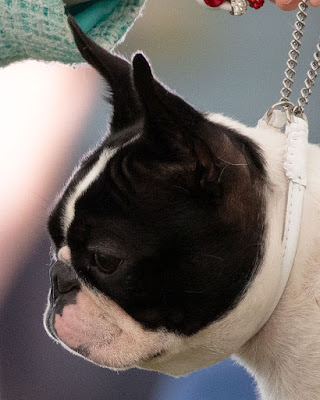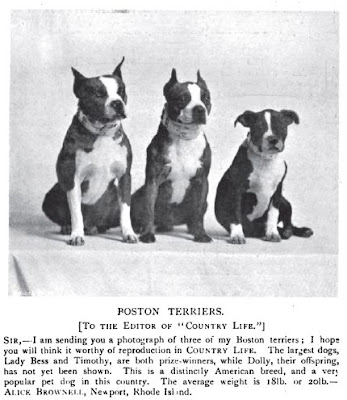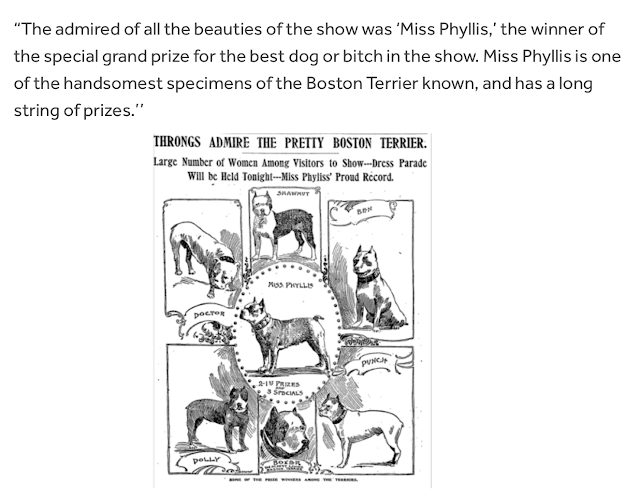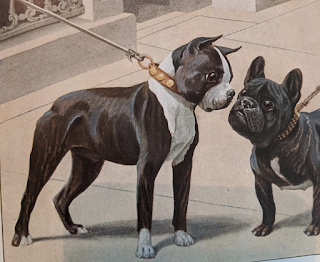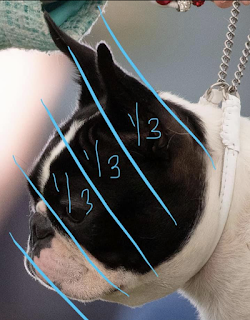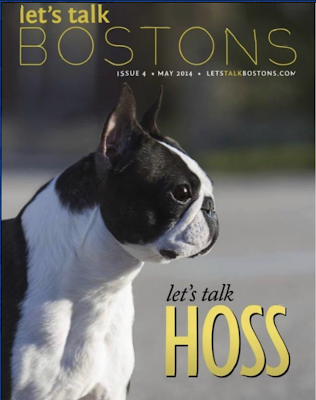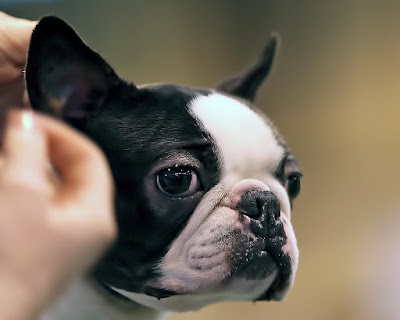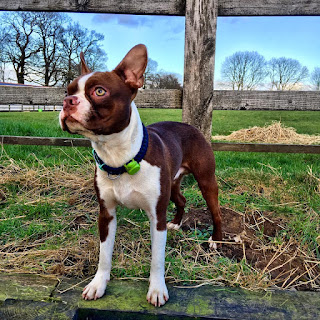This {photograph} stopped me in my tracks this week. It exhibits Picture Catcher of Ziost, who gained the bitch CC at Crufts 2020 earlier this yr. Her win is just not a one-off. She has since been made as much as a Champion.
As she’s barely turning away within the prime pic, listed below are a pair extra exhibiting that her face actually could be very flat.
The explanation it stopped me in my tracks is as a result of the Boston used to have a muzzle and neither had been their precise noses pushed again into the face like this. This is a champ from 1910.
These winners are from round that point, too.
So how did a breed that after had a muzzle find yourself with out one?
There are three principal causes. First is the pernicious impact of the show-ring which too usually results in exaggeration over time. Second is the cult-like lure of brachcycephaly that has remodeled a number of breeds (and threatens a number of others). The third, barely extra shocking one, is that the breeders have full-on fucked-up of their studying of the breed customary.
This is the way it occurred…
The Boston Terrier was first recognised within the US within the Eighteen Nineties.
Under is a contemporaneous report and illustraiton of the 1898 Boston Breeders Membership Canine Present (in Boston itself, I imagine),the place muzzles, albeit of varied lengths, are very a lot in proof.
Within the 1910 breed customary it states this:
“MUZZLE – Quick, sq., large and deep, with out wrinkles…. the jaw broad and sq., with brief, common enamel”
Ten years later, there was a revision that included a max muzzle size (my bolding).
“MUZZLE – brief, sq., large and deep, and in proportion to cranium;’ free from wrinkles; shorter in size than in width and depth, not exceeding in size roughly one-third of size of cranium; width and depth carried out nicely to finish; the muzzle from cease to finish of nostril on a line parallel to the highest of the cranium”
Additionally of curiosity within the 1920 customary are the top faults listed – too brief a cranium and a jaw that turned up (as within the Bulldog).
“HEAD FAULTS – Cranium “domed” or inclined; furrowed by a medial line; cranium too lengthy for breadth, or vice versa; cease too shallow; brown and cranium to slanting… Muzzle wedge formed or missing depth; down confronted; an excessive amount of minimize under the eyes; pinched nostrils; protruding enamel; weak decrease jaw; exhibiting “turn-up”
In 1919, the Nationwide Geographic Guide of Canines described the Boston’s muzzle like this:
“The face is clever, relatively sq., the nostril, whereas brief, is just not pushed in, and the jaws are even, broad and pretty deep. He’s in each sense a superb sensible canine.”
And that, certainly, is what the accompanying illustration exhibits (right here with a French Bulldog).
In 1926, breed historian E J Rousuck supplied this clarification re muzzle proportions:
“Conforming to stipulate to almost each different a part of the Boston’s head, the muzzle have to be sq.. It ought to be as excellent a sq. as doable, its width and depth and size being about equal; the “about” which means that the slight deviation will most likely happen in its size as a result of, inasmuch as blockiness is a real requisite, the goal has ever been towards a brief nostril. The muzzle ought to come out squarely from the cease, its size not exceeding one third of the whole head, that’s, the space from tip of nostril again horizontally so far as the set-on of the ears, ought to measure 3 times the size of the muzzle.”
As we speak’s AKC customary now says this:
“The muzzle is brief, sq., large and deep and in proportion to the cranium. It’s free from wrinkles, shorter in size than in width or depth; not exceeding in size roughly one-third of the size of the cranium.”
And it additionally now permits an underbite, by no means part of the unique customary.
“The jaw is broad and sq. with brief common enamel. The chunk is even or sufficiently undershot to sq. the muzzle”
We now even have some Boston breeders speaking about layback – basically a nostril that recedes into the top like this, aided and abetted by the removing of an upturned jaw as a fault being faraway from the usual.
Sadly, the max-third demand is now interpreted by show-breeders as one thing to keep away from in any respect prices and since too-short-a-muzzle has been eliminated as a head fault, there’s nothing to stop fanciers breeding the face off the canine.
Leaving apart the truth that “muzzle” can’t presumably imply simply the mandible (decrease jaw), it’s a plain improper interpretation of the breed customary.
A canine’s cranium is not only from occiput to cease – it’s the complete head, as E J Rousuck made clear in 1926, writing: “The muzzle ought to come out squarely from the cease, its size not exceeding one third of the whole head, that’s, the space from tip of nostril again horizontally so far as the set-on of the ears, ought to measure 3 times the size of the muzzle.”
To recommend in any other case could be thought-about a nonsense by any anatomist. However sadly, we have seen this error additionally seem in different breeds the place it has additionally been used to justify more and more brachycephaly – “brachy creep” as we have dubbed it on CRUFFA.
Now it’s true that there was some variation in muzzle size through the years, and it’s doable to seek out previous Champions with a really brief muzzle, solely lately has it led to canines as excessive as this canine, a present champion within the US.
And canines like these within the UK show-ring.
I lately noticed this breeder meme, produced in response to latest laws within the Netherlands that prohibits the breeding of extraordinarily brachycephalic canines.
The irony is that if they’d caught to muzzles the size of the canine on the proper, the breed wouldn’t now be one of many 12 excessive brachycephalics whose breeding has been restricted within the Netherlands.
In reality, Bostons like this (and yep, they do nonetheless exist) are positive to be bred within the Netherlands as a result of they meet the demand for a muzzle that may be a third the size of the entire head. It is completely within-standard, too, however present breeders would dismiss this canine as “pet-bred”… the improper color… and much too “snouty”
The newest pattern is for present breeders to assert themselves “preservation breeders”, apparently oblivious to the truth that the canines they’re breeding in the present day usually look nothing like the unique canines. They are going to let you know the canines are unchanged in 150 years, asking us to not imagine our mendacity eyes.
So does it matter? In spite of everything, we all know that the Boston is a greater breather than its fleshier cousins the Frenchie, Bulldog and Pug.
However this isn’t nearly respiratory (though some Bostons do battle). Canines’ muzzles are the place you discover their cooling system. Crush them and the canines overheat. Brachy mouths are additionally virtually all the time a multitude with rotated/crowded/mismatched enamel – an under-recognised reason for trauma and ache. A scarcity of a muzzle additionally makes eyes very susceptible – as admitted by the Boston Terrier Membership of the USA.
“As a result of their eyes protrude and their muzzles are brief, there’s an elevated likelihood over different canines that they may scratch their eyes by chance. When strolling along with your Boston by no means enable them to come back into contact with thorny vegetation.”
So sure, it does matter. All canines want a muzzle – as a bodily buffer, as air-con and for a snug mouth.
POINTS OF ACTION:
• introduce a minimal muzzle size into the breed requirements of breeds susceptible to brachy creep
• KCs and breed golf equipment to teach and encourage sincere debate about phenotypic adjustments within the breed, with an emphasis on what’s and is not an enchancment from a welfare perspective
• extra emphasis on the perils of shortening muzzles in judges’ coaching
• add “brachy creep” to the KC’s Breedwatch for the Boston (and different breeds the place it’s evident – eg Dogue de Bordeaux, Boxers, Newfies and sadly many others).
And some extent of motion for me personally: to present the Brachycephalic Working Group a kick up the bum. Arrange in 2016 by the Kennel Membership after a veterinary petition calling for brachy reform was signed by over 40,000 veterinary skilled), progress has been glacial – notably re adjustments to breed requirements that had been reported to be imminent greater than a yr in the past.




